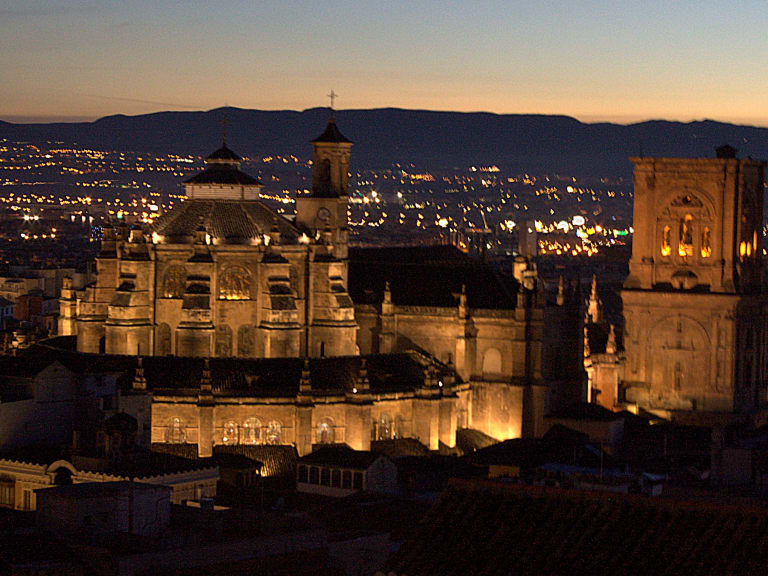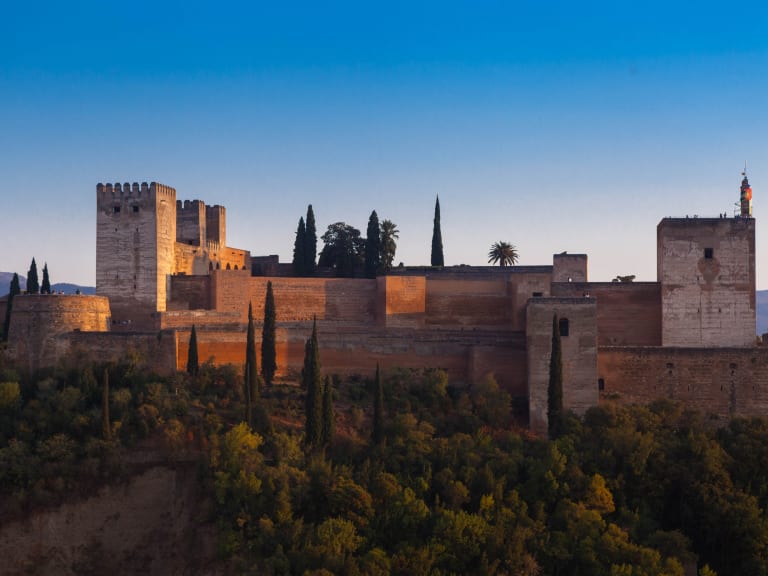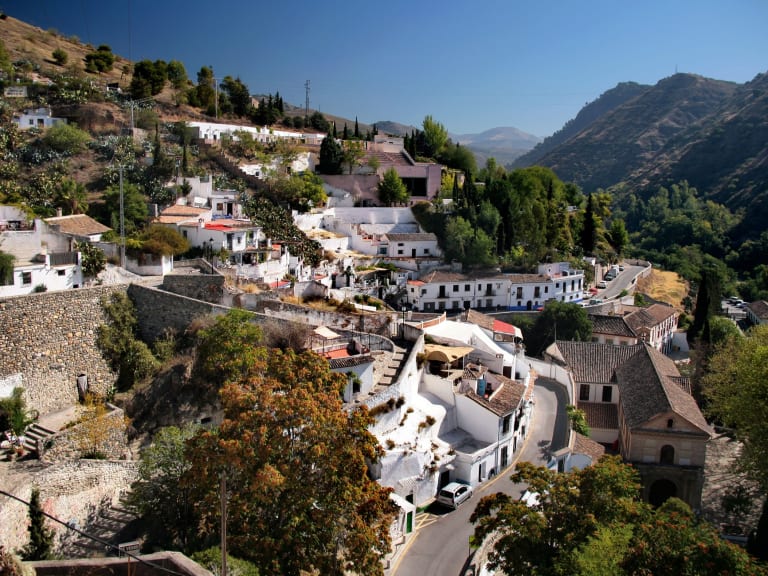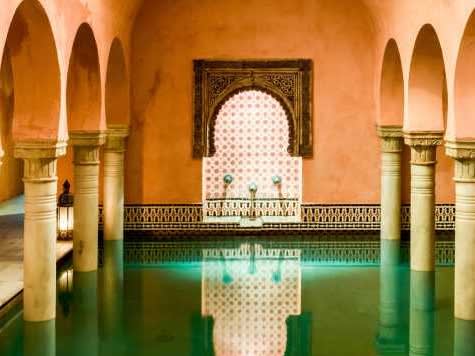More about: Best Things To Do In Granada In 4 Days
There is always something to see and do in Granada, the Nasrid capital and home of flamenco, tapas and, of course, the Alhambra. Luckily, you'll be in the city for four days and you'll have time to see not only the must-sees, but also those hidden treasures that are well worth a visit, such as the Paseo de los Tristes.
As I understand that sometimes organising the itinerary can be overwhelming, I have prepared a proposal for you to make the most of each day. You will visit the quintessential neighbourhoods of Granada, such as Sacromonte and Albaicín, as well as historic buildings (not only the Alhambra, but also the Cathedral, with its Royal Chapel, or the Royal Monastery of San Jerónimo). Have you got everything ready?
Day 1: A stroll through the historic centre of Granada

On your first day in Granada, I recommend that you spend it getting to know the emblems of the historic centre of the city, such as the Cathedral and the Royal Chapel. It is an area where everything is close by, so you can walk around while you discover these historical treasures.
Start the day at the Plaza de Isabel la Catolica
The place from which the best tours of Granada start is the Plaza de Isabel Católica. You won't have any trouble finding it, as it's right in the centre, between Gran Vía and Reyes Católicos streets. In its centre there is a fountain with a sculpture commemorating the agreement that Columbus reached with the monarchs and that would end with the conquest of America.
As well as appreciating the square, I recommend a quick visit to the church, which belongs to the Convent of the Barefoot Carmelites. Inside you can see a famous sculpture of the Holy Family by Alonso de Mena.
Take a visit to the immense Cathedral of Granada
Just a two-minute walk from the Plaza Isabel la Católica is the Cathedral of Granada, a must-see. It was built by order of the queen on the site of an old mosque in the city. You will be amazed when you arrive and see its size, as it is one of the largest in Europe.
During your visit to the Cathedral of Granada you must not only admire its façades, but also its interior.
It costs around €5 to enter and is well worth it to understand why it is considered one of the great jewels of the Spanish Renaissance. Pay special attention to its stained glass windows and organ, which has been there since the 18th century.
Step inside the great mausoleum of the Royal Chapel
The Royal Chapel of Granada is part of the Cathedral complex, so you can enter with the same ticket, which costs around €5.
However, there is so much to see that it could be considered a completely independent visit. The highlight is that the Catholic Monarchs and their descendants are buried there.
The tombs of Isabella of Castile and Ferdinand of Aragon are two great works of art; designed by Domenico Fancelli, they are made of the finest Italian marble. In addition to these tombs, there are many other works of art, especially gold and silver work.
Take a stroll and have a bite to eat in the Alcaicería
After visiting the whole monumental complex of the Cathedral of Granada, including the Chapel, you may be hungry. A good place to eat is Calle de la Alcaicería, just a three-minute walk away.
Since the 14th century it has been a large market. Nowadays, as well as silks, handicrafts and silverware, there are also restaurants and tea shops serving Arabic food.
After lunch, take a stroll through the Alcaicería, which is like an open market. Through its shops you can learn about the culture and history of the place, which was once the great souk of Granada.
Enter the Madraza, Granada's first university
Before ending the day, I suggest you visit the Madraza of Granada, which is next to the Alcaicería and the Cathedral.
This building housed the city's first university during the Nasrid period. In fact, its name comes from the Arabic "medersa", which means school.
Today you can visit its interior, which became baroque after the conquest of Granada by the Christians. Admission costs around €2.
Although many objects have been lost or destroyed over the years, you can still see remains of the Moorish construction, such as the mihrab (the oratory). It is also advisable to go upstairs to the Knights' Hall.
Before the end of the day, pay a visit to the Corral del Carbón
You may not have heard much about the Corral del Carbón, but I promise you that when you go you won't regret visiting it. This place has had many functions since its construction in the 14th century: coal storehouse, wheat market, merchants' lodgings, neighbourhood house... Nowadays it can be visited free of charge.
The Corral del Carbón is a Moorish construction, so it has Arab elements (such as the horseshoe arch at the entrance). The most striking feature is the ceiling, whose vaults are beautifully decorated with muqarnas.
Get to know Granada's nightlife
On your way out, I encourage you to enjoy the night-time atmosphere of Granada's historic centre, when the buildings you have seen throughout the day are illuminated and people dine or have a drink around them.
Depending on your age you will find different areas to enjoy a last drink. Younger people can head to Calle Pedro Antonio de Alarcón, the centre of the bustling university nightlife.
If you prefer something quieter, you should go to one of the bars on Calle Elvira or go to the area near the Plaza de Toros.
Day 2: Discover the secrets of the Alhambra

I don't think you can wait much longer to see the famous Alhambra in Granada, so spend the second day discovering the whole enclosure (which is not small) and the surrounding area.
Enter the interior of the Alhambra
My advice is to book a guided tour of the Alhambra in Granada. It is a huge palace complex with a lot of history; think that it was founded in the 13th century by the Nasrid dynasty, but at the end of the 15th century, with the conquest of the Catholic Monarchs, it underwent many modifications.
Another recommendation is to buy your tickets to the Alhambra in Granada in good time, as there are always many visitors and it tends to sell out.
They cost approximately €14 and also include a visit to the Nasrid Palaces, to which access is somewhat restricted and subject to strict timetables.
Take a stroll through the Generalife Gardens
You cannot leave the Alhambra without visiting Granada's Generalife, the former summer palace of the Nasrid dynasty.
Access to this place is included with the general entrance fee (approximately 14€), but it is better to consider the visit as a different one and dedicate a specific time to it.
Beyond its ostentatious interior, what is most striking about the Generalife are its gardens, full of aromatic plants, fountains, ponds, acacias... In addition, from this area you can see the Alhambra and the city of Granada.
Have lunch in the surroundings of the Alhambra
Before leaving, I recommend eating near the Alhambra. There are several tapas restaurants, as is common in Granada.
The price may be a little higher, but many of these places have unbeatable views of the Nasrid palace and its gardens.
What's more, there are restaurants near the Alhambra that, in some way, are also part of it or of the history of the Nasrid dynasty and the Catholic Monarchs. For example, the Parador de Granada was a convent built by order of the monarchs, or La Mimbre, which is in the middle of the forest.
Walk down from the Alhambra to Paseo de los Tristes
Don't let the name of this path fool you, it's a very beautiful place and a must-see. It is about 15 minutes down from the Alhambra, just across the Aljibillo Bridge.
From the Paseo de los Tristes you'll have incredible views of the palace grounds, so stop and take some great photos.
So why the name? This is where the funeral processions used to pass by on their way to the cemetery. Today what stands out is its fountain, dating from the early 17th century, and an old building that belonged to a noble family.
Say goodbye to the Alhambra from the Mirador de San Nicolás
Years ago Bill Clinton climbed up to the Mirador de San Nicolás and said that he had seen the most beautiful sunset from there.
You'll get there in 10 minutes from the Paseo de los Tristes, across the Albaicín neighbourhood. After climbing a few steps, you'll be able to see part of the city of Granada from the top and, above all, the Alhambra with the Sierra Nevada behind it.
When you get tired of the views, I recommend you take a look at the Church of San Nicolás, which is located in the square. It is a temple of Mudejar and Gothic styles; entrance is free.
Day 3: A tour of Sacromonte and Albaicín

During your third day in Granada get ready to visit the Sacromonte and Albaicín neighbourhoods, where tradition, culture and history run through every street. They are also great places for a good tapas tour, you'll see!
Start the day with a visit to the Great Mosque of Granada
The day starts at the Great Mosque of Granada, which is located in the Albaicín neighbourhood, near the Plaza de San Nicolás.
Entry is free and will allow you to see the main building, the gardens and the Centre for Islamic Studies, where historical documents and texts on Islam are collected.
Please note that this is a religious building and, although they have an open-door policy, respect is important.
When you're inside, make sure you take a few minutes to look at the wooden panels, on which episodes from the Qur'an are carved.
Stroll through the streets of the Albaicín
When you leave the Great Mosque it's time to stroll around the neighbourhood in which it is located, the Albaicín.
This district has always been considered almost like a different city but within Granada. You will be surprised by its slopes and narrow streets, but also by the small houses between big palaces.
What will also strike you is that there are many churches, but beware, these were formerly mosques. Although the Muslims who had always lived in the Albaicín were eventually expelled, their cultural and artistic heritage can still be seen today.
Take a tasty tapas tour of the Albaicín
As well as strolling through the streets, in the Albaicín you can go on one of the best tapas tours in Granada. You've been in the city for a few days now, so you'll have already realised that every drink you pay for in a bar (which costs about 2€) gets you a tapa, and with three or four like that, you'll end up eating.
Well, the Albaicín is the right neighbourhood to take a route and try the best gastronomy in Granada. What's more, this culinary tour has a guide who explains the cultural aspect of it all.
Discover the tradition of Sacromonte
Just a 15-minute walk from the Albaicín will take you to another of Granada's most traditional neighbourhoods: Sacromonte.
Here the mountains, rivers and religions have mixed over the years. Strolling through its streets is synonymous with finding a mosque, but also a synagogue and many caves.
You may be familiar with the caves, because they are the great emblems of Sacromonte. They have been inhabited by gypsy families, although nowadays they are open to visitors. If you want to go inside them, I recommend you to go to the Museo Cuevas ( about 5€/admission).
Feel the thrill of flamenco with a show in Sacromonte
The Sacromonte neighbourhood is also well known for being the birthplace of flamenco. In fact, many of the caves host flamenco shows in the evenings.
Flamenco is much more than just dance, so it is almost obligatory that you don't leave Granada without seeing it live.
If you want to go to a flamenco show in Granada, I highly recommend you to go to Sacromonte. The coexistence of cultures has also made itself felt in this art form; Muslim elements have been added to the original gypsy zambra, which makes the result even more exciting.
Day 4: Say goodbye to Granada by getting to know some of its hidden treasures

On the fourth and last day in Granada I recommend that you dedicate it to those places that are perhaps not so well known but which are just as interesting. Also, to end the trip, I have a very relaxing plan for you.
Visit the Royal Monastery of San Jeronimo
The Royal Monastery of San Jerónimo is located near the Cathedral of Granada, between the neighbourhoods of Realejo and San Ildefonso.
It was the first Christian temple to be built in the city after the conquest. You can visit the inside for about 4€, which I recommend to see its decoration and baroque architecture.
Inside, your eyes will go straight to the main chapel, where there is a large Mannerist-style altarpiece which, thanks to a recent restoration, looks impeccable. However, there are other elements that are no longer there due to the looting by the French.
Feel like you are re-entering the city through the Elvira Gate
Part of the Monastery of San Jerónimo was built with the Arab stone of the Puerta de Elvira, which is only a 10-minute walk away in Granada's Plaza del Triunfo. This gate was built in the 11th century by the Zirid sultans. Walk through it just as the citizens used to do years ago to enter this area of the city.
The gate is as per the standards of Moorish architecture. It is horseshoe-shaped and has battlements at the top. It is a pity that there may well have been a second gate, although it has not survived to the present day.
Taste the Arab tapas of the Calle Elvira
With your back to the Puerta de Elvira, turn right to enter Calle Elvira and have lunch. This time the tapas you'll be tasting will be a little different, as this area is full of restaurants and bars serving Arabic food, such as shawarmas or typical sweets.
As well as eating, in Calle Elvira you can appreciate, once again, how the Arab and Christian cultures mixed centuries ago. It is also a good place to buy souvenirs before you leave.
Discover Granada's most beautiful promenade on the Carrera del Darro
Continuing along Calle Elvira you'll end up at Carrera del Darro, your next destination.
It's a good place to go after lunch, as it runs along the left bank of the river and has a relaxed atmosphere. Brick and stone bridges and, in the distance, the Alhambra will appear, so you can say hello one last time.
The Carrera del Darro is one of the most beautiful walks in the city, perhaps because it has been in such good condition, including the bridges, for centuries. On your walk you will also find historic buildings and several Arab baths, where I suggest you make a stop.
Finish the day and the trip by relaxing in a hammam
After four days of walking around Granada, you may need to rest and relax for a while. There is no better place to do this than in an Arab bath.
In and around the Carrera del Darro there are several to choose from. The experience usually consists of a body treatment and a relaxing session for around 65€.
The best hammams in Granada are those that have kept the Arabic traditions; using aromatic oils and taking care of the decoration and rooms, they create a unique experience between steam baths and massages. You'll leave feeling like new and you'll put the finishing touch to your trip to the Nasrid city!
Getting around Granada

If you follow the itinerary I have suggested for your four-day trip to Granada, you won't need to take the car or public transport, as all distances are within walking distance.
However, if your hotel is a bit far away, you may need to take the bus to get to some of the neighbourhoods and, above all, to the Alhambra, which is on the outskirts.
Luckily, there is a good city bus service in Granada, whose frequency and routes you can check on their website. Lines such as the C30 connect the city centre with the Alhambra, while the C31, C32 and C34 pass through the Albaicín and Sacromonte neighbourhoods, which, depending on where you are staying, may be a bit far away.
An overview of your 4-day tour in Granada
So that you can have a more schematic view of your four-day itinerary in Granada, I leave you with this table where you have the essential information. Enjoy your trip!
- Day 1
- Visit the Plaza de Isabel la Católica
- Visit the Cathedral of Granada
- Enter the Royal Chapel
- Have a bite to eat in the Alcaicería
- Visit the Madraza
- End the day in the Corral del Carbón
- Day 2
- Visit the Alhambra
- Stroll through the Generalife and its gardens
- Have lunch in the surroundings of the Alhambra
- Arrive at the Paseo de los Tristes
- See Granada from the Mirador de San Nicolás
- Day 3
- Visit the Great Mosque of Granada
- Stroll through the Albaicín
- Take a tapas tour of the Albaicin
- Discover Sacromonte
- Attend a flamenco show
- Day 4
- Visit the Royal Monastery of San Ildefonso
- Cross the Elvira Gate
- Have a bite to eat in Calle Elvira
- Stroll along the Carrera de Darro
- Relax in a hammam
I'm looking forward to hearing from you about how the trip went and what your favourite moments were on this four-day trip to Granada.




